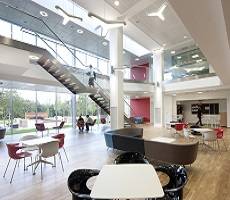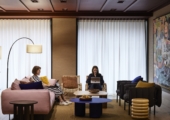October 9, 2013
iPosture generation warned to sit up straight or risk a lifetime of back pain
Ask anyone under twenty, “what is a VDU?” and they’ll probably think you’re referring to a “social” disease. Yet, despite the fact that tablet technology is in the ascent, the workplace procedure that is still used to help safeguard office workers from developing back, neck or other muscular skeletal problems is the workstation audit, as recommended in the HSE’s Working with VDUs guidance. Most under 25s would prefer to slump comfortably over a BYOD anyway, and as a result of these less than ergonomic habits , a massive 84 per cent of 18-24 year olds have admitted to suffering some incidence of back pain in the last 12 months, according to new research. (more…)























September 10, 2013
We deserve better than a polarised debate about cellular v open plan offices
by Andrew Mawson • Comment, Facilities management, Workplace design
Jacques Tati’s Playtime
Stimulated by a number of rather unsubtle commercial interests, the ‘in’ workplace discussion seems to have swung from ‘collaboration’ i.e. organisations need more new spaces for formal and informal collaborative interactions, to ‘distraction’ i.e. open plan workplaces are creating a loss of productivity because people whose work requires concentration are impeded by constant interruption. The implication of the latter is that people should keep their ‘cubes’ and open-plan should be avoided at all costs. You can see pretty quickly where the commercial axes are being ground can’t you.
(more…)